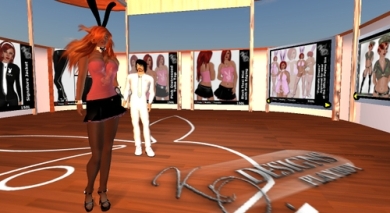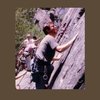Is Google the Future for Virtual Worlds? Exclusive Interview on Second Life, Showtime, Chouchou and More With Wagner James Au

Subscribe at JackMyers.com today or tomorrow to be eligible to win two (2) Yankee tickets (field level) and Yankee Club passes for the April 7th game.
Last month Harper Collins published Wagner James Au's The Making of Second Life: Notes From The New World.With a Second Life backlash in full swing (Ad Age named it most overhyped trend of 2007) and the Virtual Worlds 2008 conference kicking off this week in NYC, it was an ideal time to chat with Wagner, a unique figure in the Metaverse, particularly Second Life.
So much ink (ranging from fawning, fuzzy, to the vitriolic) has been spilled on Second Life that it's lost control of its own brand currency – approximating the Lindsay Lohan of New Media. Let's course-correct. Influenced by the fantasy of role-playing games more than the ultra-violence of shoot-'em-ups, an early vision of Second Life came together at the annual Burning Man Festival. In brief, a series of mistakes and/or workarounds laid the groundwork for a platform that was ultimately created almost entirely by Residents (the build that Linden Lab created still exists in-world, but is a ruin.)
In spring of 2003 Second Life parent Linden Lab had the foresight to hire Wagner as its town chronicler. For the next three years his byline was "Hamlet Linden" -- his avatar donning Tom Wolfe's iconic double-breasted white suit -- recording his observations on the blog New World Notes (NWN). In 2006 he went independent, known to the community thereafter as "Hamlet Au." While Wagner continues to be struck by the potential that lies within SL, he's more sociologist than evangelist. In an exclusive interview with JackMyers Media Business Report Wagner James offers a candid account of SL's past – warts and all -- and a glimpse at the future of the platform as it impacts the WWW itself.
Let's – finally -- get the numbers straight. Wagner recalls: "The early hyping press reported the number of SL accounts that have been created without reporting the number of recurringusers. Linden Lab didn't do a very good job making that distinction clear. There's like 1.4 million active users, 550,000 active monthly hardcore users-- but not 10 million. Reporters just wrote the biggest number." Because the first wave of hype flooded in before SL matured from a 3D platform with high barriers to entry, Wagner believes that "real world advertisers who came in expecting a docile audience that would line up to look at their 'brand experience' were shocked that they were being ignored, and having their ass handed to them by talented kids and housewives who were making better content than them.Smarter advertisers have stayed and learned how to tap that talent, as have real companies that are actually serious about using it as a development and prototyping platform."
Last year Komjuniti,a Hamburg-based research firm, polled 200 SL Residents. They found that 72% were disappointed with real world company activities in Second Life; just over 40% considered these efforts a one-off not likely to last. Now while this isn't inconsistent with what we see in the real world, Wagner believes that this failure mainly boils down to a failure of imagination. After all, SL is a talented community of artists, designers, and musicians demanding unprocessed experiences. Coyly, offers Wagner, "Residents prefer nude dance parties, giant frogs singing alt-folk rock, and samurai deathwatches– and often, all three at the same time." What's a brand to do?
To begin with, have a purpose. Brands who planted flags through 2006 and 2007 just wanted to get some publicity out of their tangential connection to a Virtual World, "... most of them just wanted the press hit of something, anything in Second Life, [thereby] repeating the mistakes of the dot com boom." Wagner observed first-hand that for marketers, "the best thing is a targeted campaign that really leverages what SL is and what it's best at -- dynamic collaborative creation and freeform fun. The brands that have stayed have made more of an effort to engage the community, and having a consistent presence."
Successful entrepreneurs in Second Life have launched careers by marketing their artistic expression. In-world designers create customized "skins" for avatars. Why not a Project Runway for Second Life? Wagner affirms that a few companies are moving in that direction, taping into the fashion infrastructure that's in place. Playboy – from its island on Second Life -- has commissioned SL designers to create co-branded outfits. NYC's Fashion Institute of Technology (head-to-head rival of Runway's Parsons School of Design) has expressed interest in SL's potential as a prototype platform.
L'Oreal Paris has been forward-looking in its media partnerships working with CurrentTV on viewer-created ad messages, mobile VOD content, and with E!'s The Vine, so it's intuitive that it saw value in virtual worlds. But rather than buy an island, it went small – literally – creating a presence in Greenies – a surreal SL outpost where aliens cavort in a giant house. Without fanfare, it introduced a purse filled with its product line. The venture is emblematic of a winning approach: "Up until now, the standard practice has been to create and launch an SL site fully branded with the real world advertiser's logos and trademarks. Here, instead, the client's product is subtly (and playfully) introduced into an already popular site."
Content itself is catching on in SL, particularly women-centric programming. Like L'Oreal, it made sense that Showtime would extend The L World in-world, seeing that from season one it referred constantly to The Chart – its visual map of hookups. When asked if the network might consider a deeper presence – for shows like The Tudors or Weeds – Wagner assents: "Showtime is talking about that very thing with other shows besides L Word." Since last fall, the CW'sGossip Girl (created by Millions of Us) has also curried a following on SL, racking up 40,000 unique visitors in a few months.
The mention of unique visitors deserves parsing in the context of virtual worlds. Are we measuring a user, or her avatar? Wagner agrees, noting that "residents have a different personality than their real life owner. For example, how many housewives do you know who wear 8" stilettos and devil wings? Then again, you can probably abstract even fanciful preferences and learn quite a lot about the real person; even much more than you would in other contexts, I think, because you're aggregating their imagination." In practice, he's impressed by BlogHUD, which he describes as "a heads up display that transmits screenshots and text from within SL to an aggregated blog. Not directly measuring, but tracking popular sites, places, people." Not that Second Life has shown the way forward on this score in the past: "ANYTHING is an improvement to the existing Popular Places tab in SL, which is a literal embodiment of Yogi Berra's saying about a crowded restaurant."
Two constituencies are particularly well-suited for virtual worlds: gaming and music. "There's a tremendous amount of talent and crossover with various popular games, and they can foster 'modding' communities here, especially with Havok 4 about to go Live." Music has an even more compelling scenario. He maintains that "the music industry doesn't realize that the future of live music online is here already" and offers proof embodied in Chouchou, a metaverse-only pop group. Chouchou is the brainchild of a New York-based Juliet Heberle and her counterpart Arabesque Choche in . They have never met but collaborate in full: He transmits his music digitally, she records her vocals over them, and in Second Life they are pioneering live virtual performances on their island, Islamey. Their project fuses architecture, fashion, machinima (in-world filmmaking), and of course, music, and is extended through their MySpace page and on their music videos on YouTube. Wagner opines that in the future no one will pay for recorded music, and rather than the high cost of touring, live virtual performances will be the bread and better of musicians.
Second Life's top three shops (developers/agencies both) Electric Sheep, Millions of Us, and Rivers Run Red are successful because they have sprung organically forth from SL's culture. While the embryo SL was known for anti-corporate hostility, Wagner points out that the interplay between community and the commercial has evolved: "The most active Residents tend to also be the best platform developers. Among IBM's top SL developers, for example, one is a hot babe elf, another looks like the Predator. They enjoy SL for work and play." Wagner also cites Boston's Green Grotto Studios, (which created the Playboy island) saving his highest praise for UK-based Rezzable(it worked on the L'Oreal campaign cited above).
What don't marketers get?"The most frequent misconception is thinking that they can apply understood revenue models and expectations to this new space," says Wagner. "For the first time, they're playing on a level playing field, and if they don't understand that, or how to leverage Second Life's BeBop Reality, they're going to fail." [Wagner's "BeBop Reality" alludes to SL's fungible take on both reality and physics.]
There are some recent in-world enhancements that should appeal to marketers right now: Linden Lab recently enabled streaming of static web pages, with the intent to have dynamic web pages in the near future. As Wagner sees it "This opens up a HUGE opportunity for ad networks doing a kind of Metaverse Adsense deal." (Given the presence of The L Word and Gossip Girl, GLAMand BlogHer should be interested.)
While Wagner's New World Noteswas originally intended for Second Life Residents, it attracted Boing Boing readers (consistently the #1 rated blog according to Technorati) to its ranks. The Making of Second Life: Notes From The New World according to Wagner, is targeted for a wider audience still. The type that asks: "Why was Gary Sinise going into a 'virtual world' on CSI, and what is that, anyway?"'
It's become a cliché to say that the Web and virtual worlds will soon converge, that the Internet will no longer be a semi-passive 2D medium, but instead, a fully engaged, embodied media. Pressed to elaborate on when Skynetbecomes self-aware, when a major investment will act as a catalyst, Wagner namechecks Google. In Second Life? "Across virtual worlds definitely; SL maybe. SL is going through growth pains as it goes from powerful niche to mass market; that may not be possible, but we'll see."
Wagner James Au blogs at New World Notes and can be reached via email at wjamesau@well.com. Wagner will be at the Virtual Worlds 2008 conference with books in tow. If you prefer, you can order The Making of Second Life: Notes From The New Worldonline. He's also reachable on AIM/SKYPE as SLHamlet. Jack Myers will be speaking at Virtual Worlds 2008 Thursday at 11 AM.


